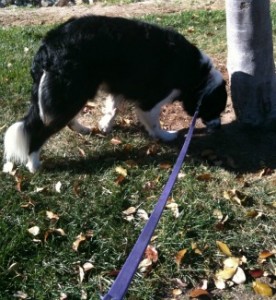 Your dog constantly pulls on the leash. It is a quick and easy way to dash the enjoyment of taking the dog out as your training partner on a regular basis.
Your dog constantly pulls on the leash. It is a quick and easy way to dash the enjoyment of taking the dog out as your training partner on a regular basis.
These 3 steps are the foundation to a fantastic leash trained dog. The golden nugget in all of this is the realization that any bad habit you have can also be changed by following the same plan. Lay out the 3 basic things you need to do differently no matter what it is and if you find yourself, or in this case your dog doing the same old habit…. Stop. And start again. You’ll be happy. And at the end of the day so will your dog.
1. Leash Length
This is the biggest mistake people make in the beginning with their dog. Too much leash.
Dogs learn and think in pictures. When giving your dog the full leash length you have physically told your dog to hang out at the end of it. You have set up the situation from the get go, allowing your dog to push the envelope and automatically lose it on all the smells! No clear boundary is set up for your dog to even know where the line of comfortable should be.
No more than 2-3 feet of leash is the new rule while walking or running.
Dogs have a sense of smell that finds many more individual odors to take in compared to humans by a thousand times. It is why canines are used as search dogs instead of training humans to locate people, narcotics or bed bugs with their noses! It is no wonder they go completely A.D.D. quickly and lose focus while in an environment other than home.
Now you at least know why your dog is prone to this annoying behavior!
Because a dog’s nose is their addiction to losing your attention you need to set up leash training so you become the default addiction. Treats and affection work wonders as a dog’s new focus.
Giving your dog only 3 feet is also key to the 1st step in no more pulling on the leash.
2. Tell Your Dog It’s Right in the Moment
Dogs do not have the ability to logic. Humans come to conclusions. Dogs need to know that they are doing what you want them to in that very moment that they are doing it. At least in the training or re-training stage.
Don’t expect your dog to walk down an entire block doing the right thing without a lot of encouragement. Reward in the moment.
Take a few steps with your dog beside you.
Reward your dog in the moment.
Take 5-10 steps and make a turn. Keep rewarding.
Do this over and over. To the point you think it’s ridiculous.
Before you know it you’ll be taking way more steps successfully with your dog beside you. Soon you’ll be to the end of the block and on to the next one.
It’s like anything new. It’s take a lot of practice. Don’t get discouraged and try to make it all the way down the block the first time.
Yes. It is a lesson for us alll. It’s described as patience. And done correctly it will bring you big reward in many areas of your life.
3. Give Directions Ahead of Time
Another big mistake us humans make when it comes to leash training is giving directions to the dog way too late.
Think of giving your dog the heads up on what you want to do way before you’re ready to make a turn, stop or move forward, sort of like you would if you were driving a car. If you were going to make a left hand turn in traffic you’d use your turn signal and begin breaking quite a ways in advance of the actual turn.
Remember the concept your dog does not process the ability to logic. Therefore giving directions after you already wanted your dog to do something can be very confusing. And if you give more than one direction, i.e “lets go”, “no”, “wait”, “stop pulling” all one right after the other without completing any of them, dogs get seriously confused. It’s easier to default to going out to the end of the leash and pulling you along in the confusion.
Tell your dog what to do ahead of time and then proceed. Pretend like each new move you want to make is a left hand turn in traffic. Give a big alert before actually expecting your dog to understand what you want to do.
The Hardest Part of Leash Training
Patience. Especially if you aren’t starting with a brand new puppy. Re-training a bad habit can be frustrating and we are conditioned to keep moving forward even if the dog doesn’t get it.
Slow down. Stop. Begin again. No one gets good at anything without a lot of practice. Only practice the things you want your dog to do and stop repeating the actions you no longer wish to be a part of. It works. It’s a good formula for anything you’d like to change in your life.
Thanks for reading. If you liked this post, please subscribe to Big Island Dog and follow me on twitter, Facebook and Google+
